Road Junction Configurations and the Severity of Traffic Accidents in Japan
Abstract
1. Introduction
2. Literature Review
- Vehicle-related factors: including lack of maintenance, failure of expendable parts (e.g., brakes, tyres, and lighting), and inherent design limitations (e.g., visibility, rigidity, and manoeuvrability);
- Road-related factors: traffic volume (Anjana and Anjaneyulu 2015 [5], Kesavareddy et al., 2018 [16]), traffic control type (Billah et al., 2021 [12]), speed limit (Xu et al., 2018 [17]), pavement design and conditions, geometric design (Xie et al., 2013 [18], Zhang et al., 2015 [11]), light condition (Zubaidi et al., 2022 [19]), insufficient lane and shoulder width, degree of curvature (Bíl et al., 2019 [20]);
- Driver/road-user-related factors: seat belt usage (Chen et al., 2012 [4]), driving under the influence (e.g., alcohol, drugs), violation of traffic regulations (e.g., speeding, red light violation (Alghafli et al., 2021 [21]), stop sign violation), mental state of and inattention by the driver (Sagberg et al., 2019 [22], Sundfør et al., 2019 [3]), driver’s experience and demographic profile (e.g., age, gender, ethnicity (Penmetsa and Pulugurtha (2018) [14]);
3. Data and Methodology
3.1. Data
3.2. Binomial Logistic Regression Analysis
3.2.1. Setting the Independent and Dependent Variables
3.2.2. Variable Selection by Stepwise Method
3.3. The Junction Configuration and the Seriousness of the Outcomes
3.4. Testing the Robustness of the Model
3.5. Likelihood Ratio Test
4. Results
4.1. Impact of the Junction Interval
- Almost all models, including the model that examined all accident types together, showed a monotonic increase of the rate of fatal/serious injury cases. This owes to the fact that, during the stepwise selection process, only the linear junction interval variable (x) came through for most accident types (and the remaining terms in the forms of were not adopted as the independent variable). As the regression coefficient was positive and significant (α = 0.01), the entire data increased monotonically. For this reason, we can conclude that, in general, the longer the distance between junctions, the more likely it will lead to fatal or serious injury accidents.
- One of the two exceptions was the model for [vehicle-to-vehicle collisions at four-armed junctions with the other party aged 16–64], which followed a square curve with a single peak, reaching the highest risk at a junction interval of 32 m, and subsequently showing a distance decay.
- The other exception was the model for [vehicle-to-pedestrian accidents at three-armed junctions with the other party aged 16–64], which followed a cubic function with one valley or the lowest risk at 20 m and one peak or the highest risk at 43 m.
4.2. Impact of the Junction Angle
- In the case of [vehicle-to-vehicle accidents at four-armed junctions with the other party aged 16–64], the rate of serious outcomes monotonically increases; i.e., the larger the smallest junction angle, the higher the risk of serious outcomes for the accident.
- For the models of [vehicle-to-motorcycle accidents at three-armed junctions with the motorcyclist aged 16–64 years old] and [vehicle-to-bicycle accidents at three-armed junctions with the motorcyclist aged 16–64 years old], a U-shaped curve was derived with the lowest risk of fatal/serious accidents at the junction angles of 59 degrees and 65 degrees, respectively.
- In contrast, in the case of [vehicle-to-pedestrian accidents at three-armed junctions with the pedestrian aged 16–64], a single-peak curve was observed with the fatal/serious injury rate reaching the maximum at 70 degrees.
4.3. Likelihood Ratio Testing
5. Discussion
6. Conclusions
Author Contributions
Funding
Institutional Review Board Statement
Informed Consent Statement
Data Availability Statement
Acknowledgments
Conflicts of Interest
References
- World Health Organization. Road Traffic Injuries. Available online: https://www.who.int/news-room/fact-sheets/detail/road-traffic-injuries (accessed on 16 December 2022).
- Huang, H.; Chin, H.C.; Haque, M.M. Severity of driver injury and vehicle damage in traffic crashes at intersections: A Bayesian hierarchical analysis. Accid. Anal. Prev. 2008, 40, 45–54. [Google Scholar] [CrossRef] [PubMed]
- Sundfør, H.B.; Sagberg, F.; Høye, A. Inattention and distraction in fatal road crashes—Results from in-depth crash investigations in Norway. Accid. Anal. Prev. 2019, 125, 152–157. [Google Scholar] [CrossRef] [PubMed]
- Chen, H.; Cao, L.; Logan, D.B. Analysis of risk factors affecting the severity of intersection crashes by logistic regression. Traffic Inj. Prev. 2012, 13, 300–307. [Google Scholar] [CrossRef] [PubMed]
- Anjana, S.; Anjaneyulu, M.V.L.R. Safety analysis of urban signalized intersections under mixed traffic. J. Saf. Res. 2015, 52, 9–14. [Google Scholar]
- Sharafeldin, M.; Farid, A.; Ksaibati, K. A random parameters approach to investigate injury severity of two-vehicle crashes at intersections. Sustainability 2022, 14, 13821. [Google Scholar] [CrossRef]
- Cabinet Office of Japan. White Paper on Traffic Safety in Japan. 2021. Available online: https://www8.cao.go.jp/koutu/taisaku/kou-wp.html (accessed on 16 December 2022).
- Japan Society of Traffic Engineers. Heimen Kōsa no Keikaku to Sekkei (Planning and Design for At-Grade Intersection); Japan Society of Traffic Engineers Publications: Tokyo, Japan, 2018; pp. 11–13. (In Japanese) [Google Scholar]
- Ministry of Land, Infrastructure, Transport and Tourism. Priority Elimination Strategy for High Accident-Risk Zones. Available online: https://www.mlit.go.jp/road/road_e/s1_safety.html (accessed on 16 December 2022).
- European Commission. Mobility & Transport—Road Safety: Junctions. Available online: https://road-safety.transport.ec.europa.eu/statistics-and-analysis/statistics-and-analysis-archive/roads/junctions_en (accessed on 16 December 2022).
- Zhang, Y.; Fu, C.; Cheng, S. Exploring driver injury severity at intersection: An ordered probit analysis. Adv. Mech. Eng. 2015, 7, 567124. [Google Scholar] [CrossRef]
- Billah, K.; Adegbite, Q.; Sharif, H.O.; Dessouky, S.; Simcic, L. Analysis of intersection traffic safety in the city of San Antonio, 2013–2017. Sustainability 2021, 13, 5296. [Google Scholar] [CrossRef]
- Haleem, K.; Abdel-Aty, M.A. Examining traffic crash injury severity at unsignalized intersections. J. Saf. Res. 2010, 41, 347–357. [Google Scholar] [CrossRef]
- Penmetsa, P.; Pulugurtha, S.S. Modeling crash injury severity by road feature to improve safety. Traffic Inj. Prev. 2018, 19, 102–109. [Google Scholar] [CrossRef]
- Eboli, L.; Forcinitia, C.; Mazzullaa, G. Factors influencing accident severity: An analysis by road accident type. Transp. Res. Proc. 2020, 47, 449–456. [Google Scholar] [CrossRef]
- Kesavareddy, S.; Haleem, K.; Doustmohammadi, M.; Anderson, M. Comparing the crash injury severity risk factors at high-volume and low-volume intersections with different traffic control in Alabama. Int. J. Stat. Appl. 2018, 8, 173–188. [Google Scholar]
- Xu, X.; Šarić, Ž.; Zhu, F.; Babić, D. Accident severity levels and traffic signs interactions in state roads: A seemingly unrelated regression model in unbalanced panel data approach. Accid. Anal. Prev. 2018, 120, 122–129. [Google Scholar] [CrossRef] [PubMed]
- Xie, K.; Wang, X.; Huang, H.; Chen, X. Corridor-level signalized intersection safety analysis in Shanghai, China using Bayesian hierarchical models. Accid. Anal. Prev. 2013, 50, 25–33. [Google Scholar] [CrossRef]
- Zubaidi, H.; Alnedawi, A.; Obaid, I.A.; Abadi, M.G. Injury severities from heavy vehicle accidents: An exploratory empirical analysis. J. Traffic Transp. Eng. 2022, 9, 991–1002. [Google Scholar] [CrossRef]
- Bíl, M.; Andrášik, R.; Sedoník, J. Which curves are dangerous? A network-wide analysis of traffic crash and infrastructure data. Transp. Res. Part A Policy Pract. 2019, 120, 252–260. [Google Scholar] [CrossRef]
- Alghafli, A.; Mohamad, E.; Ahmed, A.Z. The effect of geometric road conditions on safety performance of Abu Dhabi Road intersections. Safety 2021, 7, 73. [Google Scholar] [CrossRef]
- Sagberg, F.; Johansson, O.J.; Sundfør, H.B. Combining roadside interviews and on-road observation for assessing prevalence of driver inattention. Transp. Res. Part F Traffic Psychol. Behav. 2019, 62, 305–315. [Google Scholar] [CrossRef]
- Behnood, A.; Mannering, F. Time-of-day variations and temporal instability of factors affecting injury severities in large-truck crashes. Anal. Methods Accid. Res. 2019, 23, 100102. [Google Scholar] [CrossRef]
- Makarova, I.; Buyvol, P.; Yakupova, G.; Mukhametdinov, E.M.; Pashkevich, A. Identification for factors and causes affecting the traffic accident severity. In Proceedings of the XII International Science-Technical Conference AUTOMOTIVE SAFETY, Kielce, Poland, 21–23 October 2020; pp. 1–6. [Google Scholar]
- Ahmed, M.; Franke, R.; Ksaibati, K.; Shinstine, D. Effects of truck traffic on crash injury severity on rural highways in Wyoming using Bayesian binary logit models. Accid. Anal. Prev. 2018, 117, 106–113. [Google Scholar] [CrossRef]
- Asare, I.O.; Mensah, A.C. Crash severity modelling using ordinal logistic regression approach. Int. J. Inj. Control Saf. Promot. 2020, 27, 412–419. [Google Scholar] [CrossRef]
- Greibe, P. Accident prediction models for urban roads. Accid. Anal. Prev. 2003, 35, 273–285. [Google Scholar] [CrossRef] [PubMed]
- Abdel-Aty, M.; Wang, X. Crash estimation at signalized intersections along corridors: Analyzing spatial effect and identifying significant factors. Transp. Res. Rec. 2006, 1953, 98–111. [Google Scholar] [CrossRef]
- Xie, K.; Wang, X.; Ozbay, K.; Yang, H. Crash frequency modeling for signalized intersections in a high-density urban road network. Anal. Methods Accid. Res. 2014, 2, 39–51. [Google Scholar] [CrossRef]
- Yoshida, Y.; Harata, N. Estimation of the BPR Parameters for Equilibrium Assignment. J. Jpn. Soc. Civ. Eng. 2002, 695, 91–102. (In Japanese) [Google Scholar] [CrossRef]
- Hashimoto, S.; Taniguchi, M.; Mizushima, S.; Yoshiki, S. A study in the relationship between steet structures and vehicle speeds. Infrastruct. Plan Rev. 2010, 27, 737–742. (In Japanese) [Google Scholar] [CrossRef]
- Archer, J.; Fotheringham, N.; Symmons, M.; Corben, B. The Impact of Lowered Speed Limits in Urban/Metropolitan Areas; Monash University Accident Research Centre Report; Monash University Accident Research Centre: Clayton, Australia, 2008; No. 276; p. 71. [Google Scholar]
- Savolainen, P.; Mannering, F. Probabilistic models of motorcyclists’ injury severities in single- and multi-vehicle crashes. Accid. Anal. Prev. 2007, 39, 955–963. [Google Scholar] [CrossRef] [PubMed]
- Morichi, S.; Hamaoka, H. A study on the perception of hazard for traffic accident. Infrastruct. Plan. Rev. 1995, 12, 713–718. (In Japanese) [Google Scholar] [CrossRef]
- Asgarzadeh, M.; Verma, S.; Mekary, R.A.; Courtney, T.K.; Christiani, D.C. The role of intersection and street design on severity of bicycle-motor vehicle crashes. Inj. Prev. 2017, 23, 179–185. [Google Scholar] [CrossRef]
- Miaou, S.P. The relationship between truck accidents and geometric design of road sections: Poisson versus negative binomial regressions. Accid. Anal. Prev. 1993, 26, 471–482. [Google Scholar] [CrossRef]
- Zewde, T. Determinants that lead drivers into traffic accidents: A case of Arba Minch City, South Ethiopia. Sci. J. Appl. Math. Stat. 2017, 5, 210–215. [Google Scholar] [CrossRef]
- Srinivas, S.; Venkata, R. Pedestrian crash estimation models for signalized intersections. Accid. Anal. Prev. 2011, 43, 439–446. [Google Scholar]
- Hsu, Y.T.; Chang, S.C.; Hsu, T.H. Analysis of traffic accident severity at intersection using logistic regression model. J. Eng. Res. Rep. 2020, 13, 1–9. [Google Scholar] [CrossRef]
- Karacasu, M.; Ergül, B.; Yavuz, A.A. Estimating the causes of traffic accidents using logistic regression and discriminant analysis. Int. J. Inj. Control Saf. Promot. 2013, 21, 305–313. [Google Scholar] [CrossRef] [PubMed]
- Bauer, K.M.; Harwood, D.W. Statistical Models of At-Grade Intersections Accidents—Addendum; FHWA Report-99-094; Federal Highway Administration: McLean, VA, USA, 2000.
- Garrido, R.; Bastos, A.; de Almeida, A.; Elvas, J.P. Prediction of road accident severity using the ordered probit model. Transp. Res. Proc. 2014, 3, 214–223. [Google Scholar] [CrossRef]
- Wu, Q.; Zhang, G.; Ci, Y.; Wu, L.; Tarefder, R.A.; Alcántara, A.D. Exploratory multinomial logit model–based driver injury severity analyses for teenage and adult drivers in intersection-related crashes. Traffic Inj. Prev. 2016, 17, 413–422. [Google Scholar] [CrossRef]
- Anderson, J.C.; Hernández, S. Roadway classifications and the accident injury severities of heavy-vehicle drivers. Anal. Methods Accid. Res. 2017, 15, 17–28. [Google Scholar] [CrossRef]
- Northmore, A.B.; Hildebrand, E.D. Intersection characteristics that influence collision severity and cost. J. Saf. Res. 2019, 70, 49–57. [Google Scholar] [CrossRef]
- Guo, F.; Wang, X.; Abdel-Aty, M.A. Modeling signalized intersection safety with corridor-level spatial correlations. Accid. Anal. Prev. 2010, 42, 84–92. [Google Scholar] [CrossRef]
- Basu, S.; Saha, P. Regression Models of Highway Traffic Crashes: A Review of Recent Research and Future Research Needs. Procedia Eng. 2017, 187, 59–66. [Google Scholar] [CrossRef]
- Okabe, A.; Okuniki, K.; Shiode, S. SANET team SANET Standalone: A Spatial Analysis on Networks (Ver.1.0 Beta). Available online: http://sanet.csis.u-tokyo.ac.jp/ (accessed on 16 December 2022).
- Kobayashi, T.; Simakawa, Y.; Kashima, S. Proposal of estimation classification of narrow road traffic volume. J. Traffic Eng. 2018, 4, A26–A33. [Google Scholar]
- Tonkin, M.; Woodhams, J.; Bull, R.; Bond, J.W.; Santtila, P. A comparison of logistic regression and classification tree analysis for behavioural case linkage. J. Investig. Psychol. Offender Profiling 2012, 9, 235–258. [Google Scholar] [CrossRef]
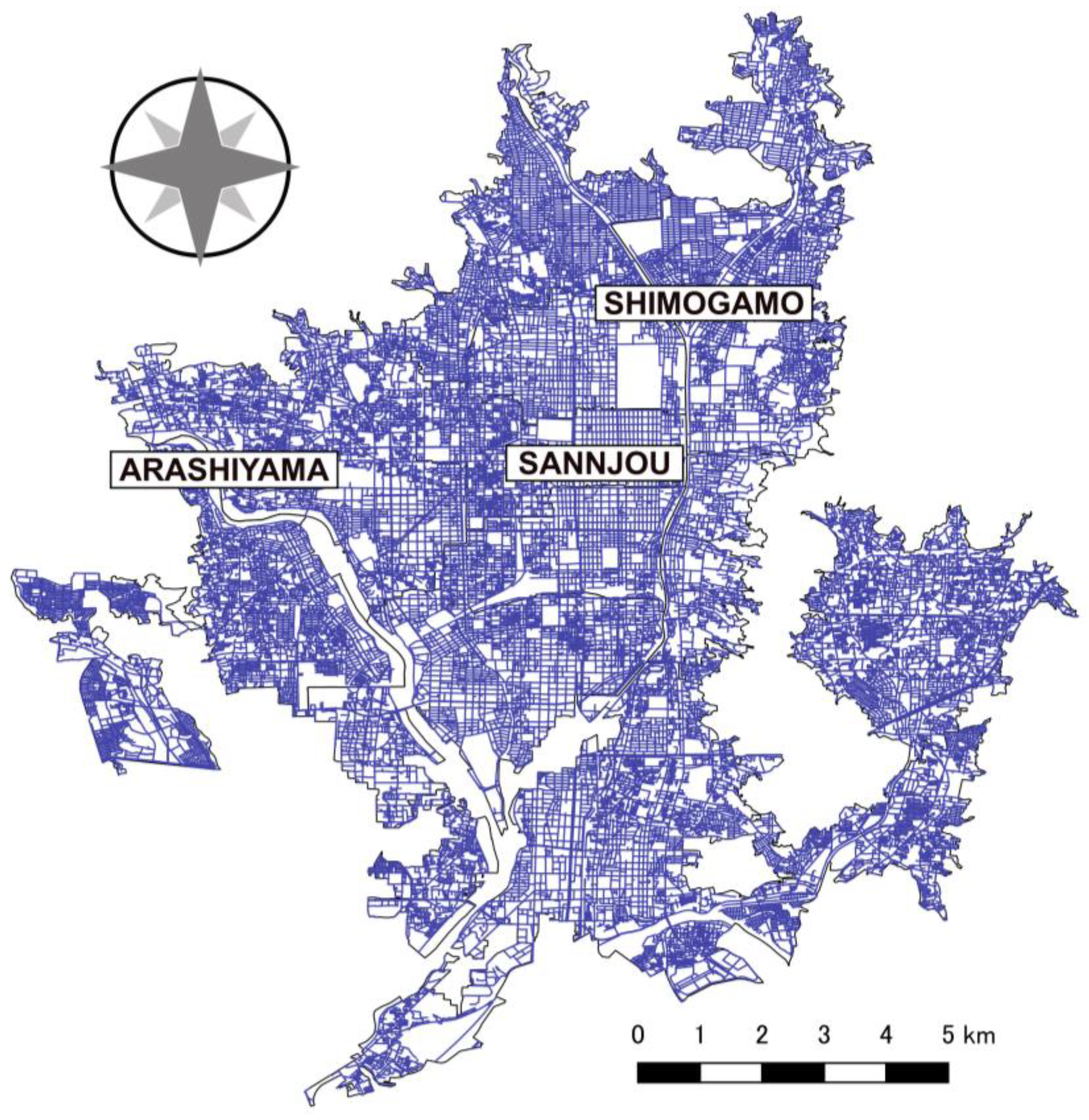
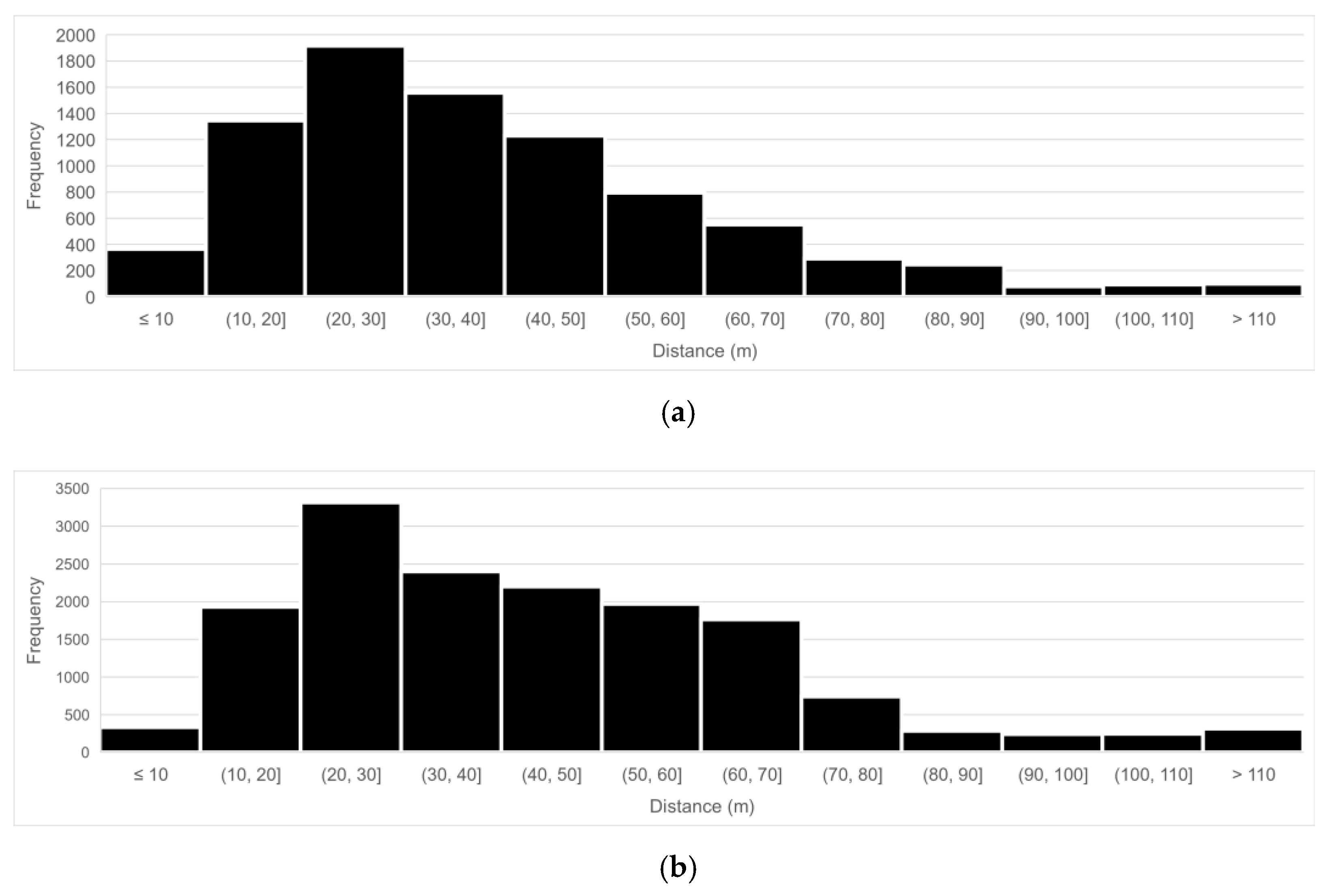
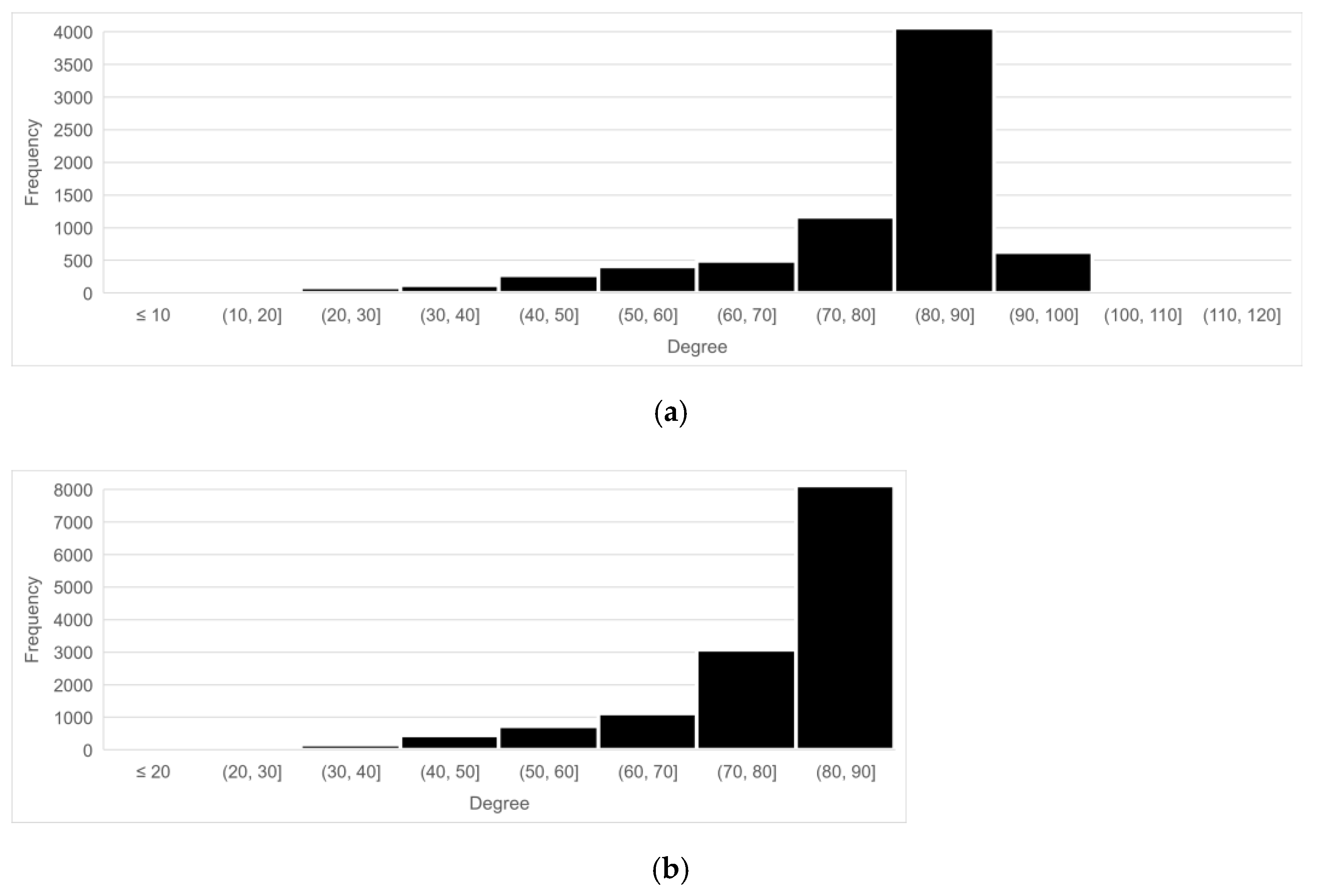
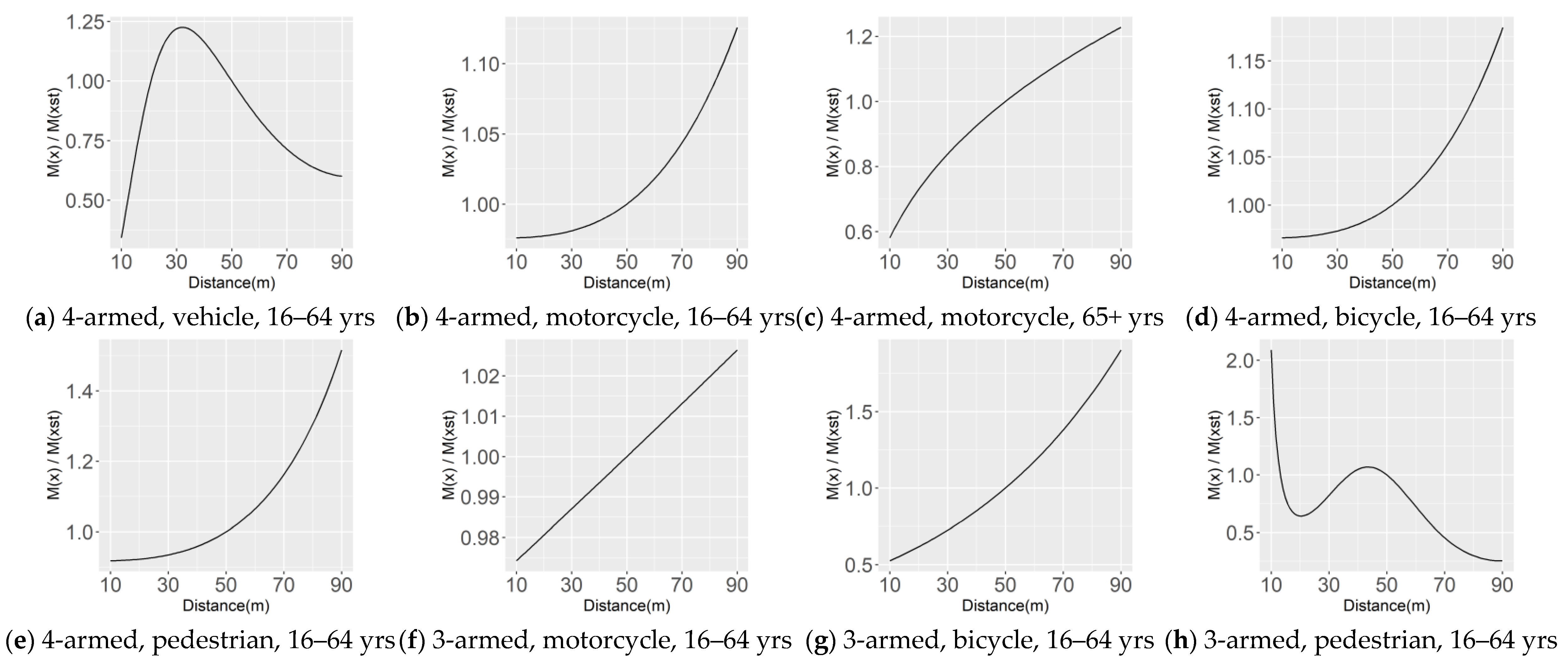
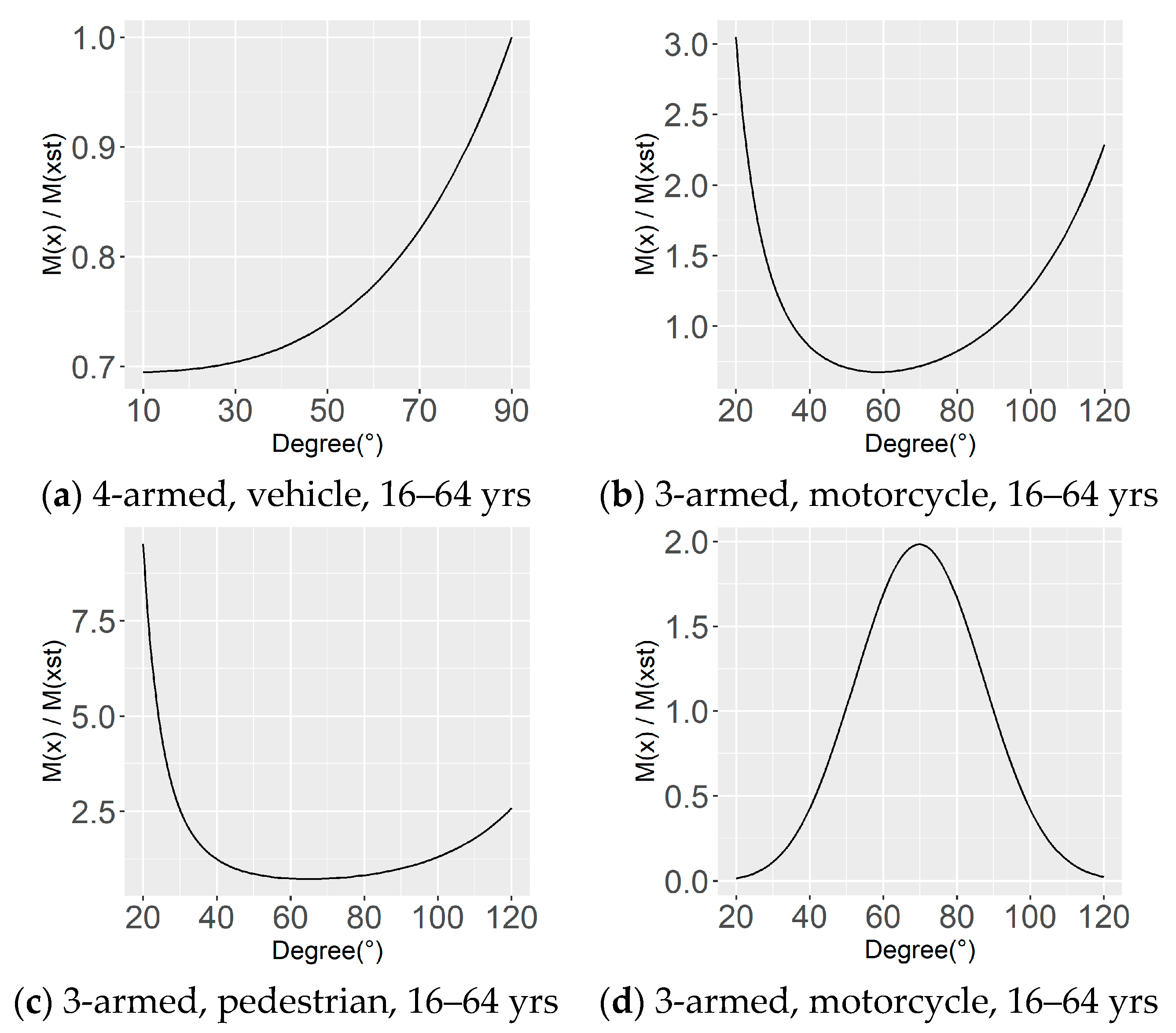
| Junction Type | Modes of Transport Involved | Age Group | All Cases | Fatal/Serious Cases Count | Fatal/Serious Case Rate |
|---|---|---|---|---|---|
| Four-armed junction | Vehicle to vehicle | 16–64 | 3475 | 147 | 4.2% |
| 65 and over | 468 | 34 | 7.3% | ||
| Vehicle to motorcycle | 16–64 | 3599 | 752 | 20.9% | |
| 65 and over | 328 | 130 | 39.6% | ||
| Vehicle to bicycle | up to 15 | 237 | 24 | 10.1% | |
| 16–64 | 2640 | 308 | 11.7% | ||
| 65 and over | 499 | 148 | 29.7% | ||
| Vehicle to pedestrian | up to 15 | 107 | 28 | 26.2% | |
| 16–64 | 695 | 132 | 19.0% | ||
| 65 and over | 374 | 178 | 47.6% | ||
| Three-armed junction | Vehicle to vehicle | 16–64 | 1877 | 49 | 2.6% |
| 65 and over | 254 | 6 | 2.4% | ||
| Vehicle to motorcycle | 16–64 | 1844 | 325 | 17.6% | |
| 65 and over | 155 | 47 | 30.3% | ||
| Vehicle to bicycle | up to 15 | 173 | 25 | 14.5% | |
| 16–64 | 1307 | 141 | 10.8% | ||
| 65 and over | 275 | 88 | 32.0% | ||
| Vehicle to pedestrian | up to 15 | 95 | 26 | 27.4% | |
| 16–64 | 479 | 78 | 16.3% | ||
| 65 and over | 246 | 104 | 42.3% |
| 3-Armed Junction | 4-Armed Junction | |
|---|---|---|
| Count | 8563 | 15,744 |
| Mean | 80.02 | 79.32 |
| Median | 85.76 | 84.15 |
| Mode | [85–90] | [85–90] |
| Standard Deviation | 14.15 | 12.59 |
| Kurtosis | 4.16 | 4.21 |
| Skewness | −2.03 | −1.98 |
| Range | 109.28 | 78.96 |
| Minimum | 6.55 | 10.98 |
| Maximum | 115.83 | 89.94 |
| Types of Variables | Details |
|---|---|
| Junction configuration | ] |
| Street classes | Dummy variables for prefecture road, national highway, one-way road, bypass, motorway |
| Street segment features | Dummy variables for bridge, under-path, tunnel, railroad crossing, pedestrian crossing |
| Facilities (polygon data) | Dummy variables for petrol station, parking lot, bike parking lot |
| Facilities (point data) | Bus stop, kindergarten, primary school, secondary school, university, park, care home, day care centre |
| Accident profile | Dummy variables for day/night, rain, snow, accident category, road gradient, raised pavement, gender of party involved, speed limit signage, stop sign |
| Demographic profile | Local population, proportion of male population, 14 and younger population, 65 to 74 population, 75 and older population, lived locally up to 1 year, lived locally up to 20.y.o lived locally |
| Junction lighting | Dummy variable for indicating the presence of traffic light |
| Traffic volume estimates | Ratio of road surface within 1 km grids, residential area within 1 km grids. 1 km number of stations |
| Junction Type | Modes of Transport Involved | Age Group | AUC with Training | AUC with Test Data | p-Value |
|---|---|---|---|---|---|
| Four-armed junction | Vehicle to vehicle | 16–64 | 0.84 | 0.75 | 0.153 * |
| 65 and over | 1 | 0.59 | 0.000 * | ||
| Vehicle to motorcycle | 16–64 | 0.67 | 0.66 | 0.862 * | |
| 65 and over | 0.85 | 0.75 | 0.123 * | ||
| Vehicle to bicycle | up to 15 | 1 | 0.57 | 0.000 * | |
| 16–64 | 0.70 | 0.66 | 0.351 * | ||
| 65 and over | - | - | - | ||
| Vehicle to pedestrian | up to 15 | 0.92 | 0.51 | 0.002 * | |
| 16–64 | 0.80 | 0.71 | 0.178 * | ||
| 65 and over | - | - | - | ||
| Three-armed junction | Vehicle to vehicle | 16–64 | 0.93 | 0.61 | 0.027 * |
| 65 and over | - | - | - | ||
| Vehicle to motorcycle | 16–64 | 0.74 | 0.70 | 0.325 * | |
| 65 and over | - | - | - | ||
| Vehicle to bicycle | up to 15 | 1 | 0.51 | 0.000 * | |
| 16–64 | 0.81 | 0.72 | 0.150 * | ||
| 65 and over | 0.88 | 0.68 | 0.011 * | ||
| Vehicle to pedestrian | up to 15 | 1 | 1 | incalculable | |
| 16–64 | 0.86 | 0.80 | 0.324 * | ||
| 65 and over | - | - | - |
| Junction Type | Modes of Transport | Age Group | Relationship | Extreme Value |
|---|---|---|---|---|
| Four-armed junction | Vehicle to vehicle | 16–64 | Single Peak | Max. at 32 m |
| Vehicle to motorcycle | 16–64 | Monotonic increase | N/A | |
| 65 and over | Monotonic increase | N/A | ||
| Vehicle to bicycle | 16–64 | Monotonic increase | N/A | |
| Vehicle to pedestrian | 16–64 | Monotonic increase | N/A | |
| Three-armed junction | Vehicle to motorcycle | 16–64 | Monotonic increase | N/A |
| Vehicle to bicycle | 16–64 | Monotonic increase | N/A | |
| Vehicle to pedestrian | 16–64 | One Peak and One Valley | Min. at 20 m Max. at 43 m | |
| Three-/Four-armed junctions | All accidents | All age | Monotonic increase | N/A |
| Junction Type | Modes of Transport | Age Group | Relationship | Extreme Value |
|---|---|---|---|---|
| Four-armed junction | Vehicle to vehicle | 16–64 | Monotonic increase | N/A |
| Three-armed junction | Vehicle to motorcycle | 16–64 | U-shaped curve | Min at 59° |
| Vehicle to bicycle | 16–64 | U-shaped curve | Min at 65° | |
| Vehicle to pedestrian | 16–64 | Single peak curve | Max at 70° |
| Junction Type | Modes of Transport | Age Group | Deviation | p-Value |
|---|---|---|---|---|
| Four-armed junction | Vehicle to vehicle | 16–64 | 55.6 | 0.000 * |
| Three-armed junction | Vehicle to motorcycle | 16–64 | 19.1 | 0.000 * |
| Vehicle to bicycle | 16–64 | 8.9 | 0.003 * | |
| Vehicle to pedestrian (junction interval) | 16–64 | 17.2 | 0.001 * | |
| Vehicle to pedestrian (junction angle) | 16–64 | 12.4 | 0.000 * |
Disclaimer/Publisher’s Note: The statements, opinions and data contained in all publications are solely those of the individual author(s) and contributor(s) and not of MDPI and/or the editor(s). MDPI and/or the editor(s) disclaim responsibility for any injury to people or property resulting from any ideas, methods, instructions or products referred to in the content. |
© 2023 by the authors. Licensee MDPI, Basel, Switzerland. This article is an open access article distributed under the terms and conditions of the Creative Commons Attribution (CC BY) license (https://creativecommons.org/licenses/by/4.0/).
Share and Cite
Wada, Y.; Asami, Y.; Hino, K.; Nishi, H.; Shiode, S.; Shiode, N. Road Junction Configurations and the Severity of Traffic Accidents in Japan. Sustainability 2023, 15, 2722. https://doi.org/10.3390/su15032722
Wada Y, Asami Y, Hino K, Nishi H, Shiode S, Shiode N. Road Junction Configurations and the Severity of Traffic Accidents in Japan. Sustainability. 2023; 15(3):2722. https://doi.org/10.3390/su15032722
Chicago/Turabian StyleWada, Yoshifumi, Yasushi Asami, Kimihiro Hino, Hayato Nishi, Shino Shiode, and Narushige Shiode. 2023. "Road Junction Configurations and the Severity of Traffic Accidents in Japan" Sustainability 15, no. 3: 2722. https://doi.org/10.3390/su15032722
APA StyleWada, Y., Asami, Y., Hino, K., Nishi, H., Shiode, S., & Shiode, N. (2023). Road Junction Configurations and the Severity of Traffic Accidents in Japan. Sustainability, 15(3), 2722. https://doi.org/10.3390/su15032722








